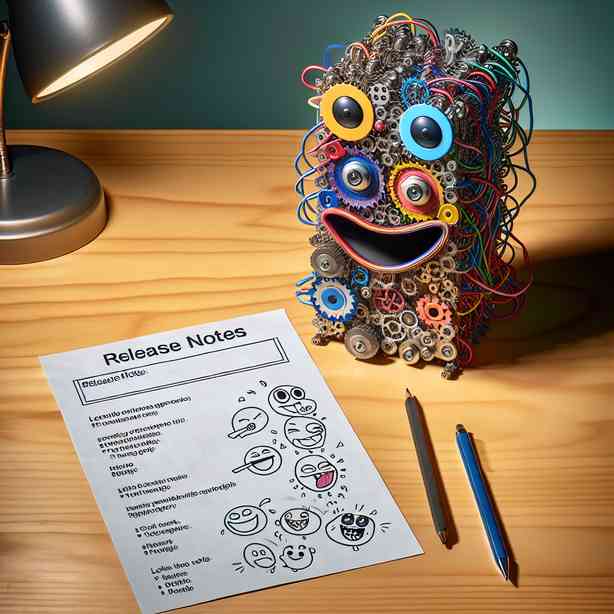
Release notes, those often overlooked details accompanying software updates, can sometimes take on a life of their own. Rather than serving merely as a list of new features, bug fixes, or improvements, they can become a source of humor and entertainment. This phenomenon highlights an interesting intersection between the technical world of software development and the human tendency to communicate in a lighthearted way. It’s fascinating to see how these seemingly mundane updates can evoke laughter and create a sense of camaraderie among users and developers alike.
At their core, release notes are intended to inform users about what has changed in a product. They may include essential information about new functionalities, enhancements, and bug fixes. However, when developers take the time to inject humor into these notes, they are crafting a narrative that goes beyond mere technical communication. This practice can serve multiple purposes: it engages users, fosters a sense of community, and reflects the company’s culture.
One of the most notable aspects of humorous release notes is their ability to humanize the development process. Software engineering, despite being seen as a rigorous and technical field, involves creativity, problem-solving, and a healthy dose of quirky personality. By adding amusing anecdotes or playful descriptions, developers invite users to see the lighter side of software updates. This approach can also alleviate the frustration that sometimes accompanies software bugs or changes, transforming a potentially tedious experience into one that elicits a smile.
For instance, many technology companies have embraced the art of humorous release notes as part of their branding strategy. A prominent example is Dropbox, which is known for including witty remarks in their updates. Their release notes often feature tongue-in-cheek comments about the updates themselves or amusing metaphors that make technical jargon more relatable. A user might read that an update will execute “faster than a caffeine-fueled squirrel” or that a bug fix was so effective it “deserves a medal.” Such phrases not only lighten the mood but also create memorable moments that users share with others.
Moreover, these lighthearted notes can foster a community around a product. When users resonate with the humor expressed in the release notes, they are more likely to engage with the brand on social media, providing an avenue for further discussion and connection. Humor acts as a social lubricant, allowing users to feel more connected not only to the product but also to the team behind it. This community-building aspect can enhance user loyalty, making it more likely that customers will stick with a product even through its ups and downs.
Of course, crafting the perfect humorous release note is an art in itself. It requires a delicate balance between wit and relevance. If the humor is too far removed from the actual content, it may confuse users rather than amuse them. Developers must be keenly aware of their audience, ensuring that the jokes resonate with them and don’t alienate anyone. The best humorous notes are those that maintain professionalism while still allowing personality to shine through.
The role of humor in release notes can also serve as a fascinating case study in marketing and product management. A well-crafted release note can be a marketing tool in disguise. When users find joy in reading updates, they are more likely to explore new features and utilize the product more effectively. This increased engagement can lead to better user retention, making humorous release notes not just a fun addition but a strategic business decision as well.
Certain companies have taken the humor approach to new heights. For example, Slack’s release notes often incorporate clever jokes and puns related to collaboration and communication, making the information more engaging. The way they present updates can transform a dry notification into something users look forward to reading, which is no small feat in a world where inboxes are inundated with messages. By turning mundane updates into enjoyable reading experiences, companies can cultivate a loyal user base that appreciates more than just functionality—they also value the experience of interacting with the brand.
Beyond fostering community and engagement, humorous release notes have the ability to become memorable. Users are likely to share funny notes with friends or colleagues, effectively turning a software update into a conversation starter. This viral potential can amplify a company’s reach far beyond its immediate user base, as laughter and humor often transcend the digital realm.
However, it is essential to acknowledge that humor in release notes may not be for every company. Organizations with a more formal or technical image might find that humor doesn’t align with their brand values or audience expectations. Thus, it is crucial for such companies to assess the appropriateness of humor in their communications thoroughly. Ultimately, a release note should reflect the personality of the company while delivering essential information clearly.
In conclusion, the emergence of humor in release notes represents a beautiful blend of technology and creativity. While they remain informative and functional, the addition of wit and humor can significantly alter their impact on users. By fostering a sense of community, enhancing user engagement, and creating memorable moments, humorous release notes have proven themselves to be an innovative communication strategy. As technology continues to evolve and the way we interact with software becomes more intertwined with our daily lives, it will be exciting to see how humor continues to play a role in shaping user experiences in the digital space. The effective use of humor in communication isn’t merely a trend; it’s a bridge that connects developers and users in a shared experience, proving that even in a world driven by algorithms and codes, there’s always room for a little laughter.


